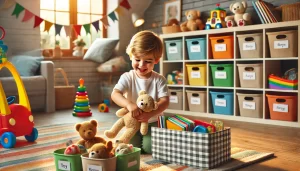Educational games are a fantastic way to make learning fun for children. The best part? You don’t need expensive toys or fancy supplies—just a little creativity and everyday household items! In this article, we’ll explore how to use simple materials to create engaging and educational games for kids at home.
Alphabet Matching Game (Using Bottle Caps)
Materials:
- Bottle caps (plastic or metal)
- Marker or stickers
- Paper
How to Play:
- Write uppercase letters on half of the bottle caps and lowercase letters on the other half.
- Mix them up and ask your child to match the uppercase and lowercase pairs.
- For an extra challenge, add pictures of objects that start with each letter.
This game helps with letter recognition, phonics, and fine motor skills.
DIY Counting Sticks (Using Popsicle Sticks)
Materials:
- Popsicle sticks
- Markers
- Stickers or small beads
How to Play:
- Write numbers 1–10 on the popsicle sticks.
- Provide stickers or beads and ask your child to place the correct number on each stick.
- You can also create simple addition and subtraction exercises using the sticks.
This activity strengthens number recognition and basic math skills.
Shape Sorting Game (Using Cardboard)
Materials:
- Cardboard
- Scissors
- Markers
How to Play:
- Cut out different shapes (circle, square, triangle, rectangle) from cardboard.
- Draw the same shapes on a larger board or piece of paper.
- Ask your child to match the cut-out shapes to their outlines.
This game enhances shape recognition and hand-eye coordination.
Word Building with Clothespins and Paper
Materials:
- Clothespins
- Small strips of paper
- Marker
How to Play:
- Write letters on clothespins.
- Write simple words on paper strips (e.g., “cat,” “sun,” “dog”).
- Have your child attach the correct clothespins to spell out the words.
This activity improves spelling, letter recognition, and fine motor skills.
Sensory Number Hunt (Using Rice or Beans)
Materials:
- A large container
- Rice or dried beans
- Small number cards (or paper pieces with numbers written on them)
How to Play:
- Bury the number cards inside the container filled with rice or beans.
- Ask your child to find and sort the numbers in order.
- You can also introduce addition or subtraction by having them find two numbers and add them together.
This activity promotes number recognition, sensory exploration, and problem-solving skills.
Sock Puppet Storytelling
Materials:
- Old socks
- Markers or fabric paint
- Buttons, glue, and yarn (optional)
How to Play:
- Decorate old socks to create puppets.
- Have your child put on a puppet show, creating their own characters and stories.
- Encourage them to act out fairy tales, make up adventures, or retell stories they’ve heard.
This game encourages storytelling, creativity, and confidence in speaking.
DIY Color Sorting Game (Using Egg Cartons)
Materials:
- An empty egg carton
- Colored paper or markers
- Small objects in different colors (buttons, beads, pom-poms)
How to Play:
- Color each egg slot with a different color.
- Provide small objects in the same colors.
- Ask your child to sort the objects into the correct color sections.
This activity helps develop color recognition and sorting skills.
Jumping Number Line (Using Paper and Tape)
Materials:
- Masking tape
- Paper
- Markers
How to Play:
- Tape a number line (1–10) on the floor.
- Call out numbers or simple math problems, and have your child jump to the correct number.
- You can also play with addition and subtraction by asking, “Jump two steps forward!”
This game builds number recognition, counting skills, and physical coordination.
Mystery Bag Sensory Game
Materials:
- A bag
- Household objects with different textures (cotton balls, a sponge, a spoon, a toy car, etc.)
How to Play:
- Place different objects inside the bag.
- Without looking, have your child feel an item and guess what it is.
- Ask them to describe how it feels (soft, hard, rough, smooth).
This activity improves sensory awareness and vocabulary skills.
Cardboard Maze Challenge
Materials:
- A shoebox lid or a piece of cardboard
- Straws or popsicle sticks
- Glue
- A small ball (like a marble or bead)
How to Play:
- Use straws or popsicle sticks to create a maze inside the shoebox lid.
- Tilt the box to guide a small ball through the maze.
- Challenge your child to navigate the ball without letting it fall out.
This game helps with problem-solving, coordination, and patience.
Final Thoughts
You don’t need expensive toys to create meaningful learning experiences for your child. With simple materials and a bit of creativity, you can make educational games that are fun and effective. Try these activities at home and watch your child learn and grow through play!




